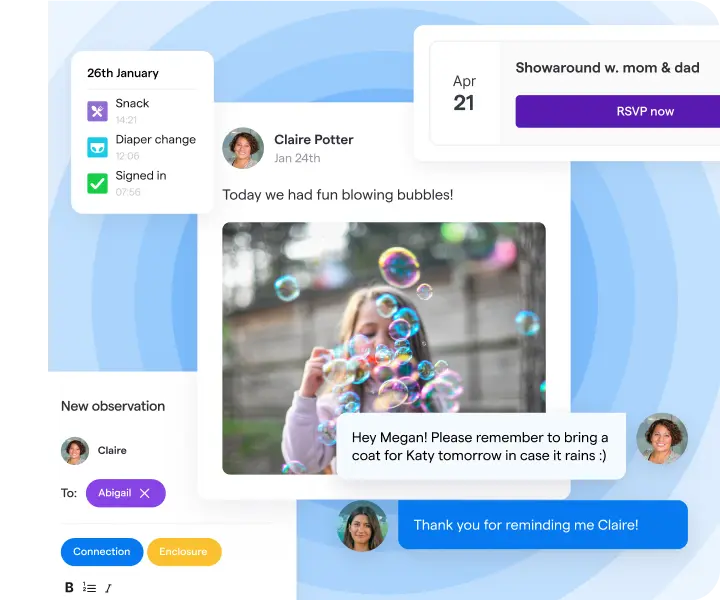settings
children
With Famly since
Why is family engagement important in ECE?
For most families, childcare is the first time they completely trust another adult with their child. In addition to helping their children's social and emotional development, families want to know that their child's learning environment is nurturing, supportive and safe. Consistent updates, posts and photos throughout the day are great and effective communication strategies that will help put families at ease.
Also, and most importantly, open and consistent communication between families and ECE staff is essential for holistic child development.
Families and teachers are the primary carers in young children’s lives as they spend the majority of their time at home or at childcare. These relationships have the most influence on children’s development, so collaboration and positive relationships between ECE staff and families is essential.
In essence, strong parent-teacher communication acts as a bridge between home and childcare, facilitating a seamless transition that supports continuous learning and fosters children's education and development across their environments.

Building parent-teacher relationships: don’t forget the fundamentals of two-way communication
While this may seem obvious, it is especially important to remember the basics of communication in order to have meaningful and honest conversations and foster positive relationships with families. The fundamentals of effective communication includes respect, consideration and inclusion, honesty and active listening.
Respect, consideration and inclusion
Make sure when families join your center, that you have all the necessary background information so that you can feel confident when communicating.
- Cultural background (religion, values, beliefs)
- Preferred language
- Use preferred titles and pronouns (first names, Dr., Ms., Mrs., etc.)
- Family dynamics and circumstances (single parent, living with grandparents, LGBTQ+, co-parenting, etc.)
- Home circumstances (disabilities, health issues, new to the neighborhood, etc.)
Honest, clear communication
- Make sure to use normal language, and not professional jargon.
- Get an interpreter and provide additional resources when needed
- Be accurate, factual and honest in all communication and provide clear details. For example, “Tommy was playing with the blocks, and then he saw Emily looking at the books alone, and asked if she wanted to play with him.”
- If you are asked a question and you don’t have the answer, it is okay to say that. “I need some more time to think about that, can I get back to you tomorrow?”
Active listening
- Use open-ended questions
Open-ended questions enable more information, rather than a simple “yes” or “no” which can provide staff with a better understanding of the children’s behaviors, or of what the family’s concerns are. - Don’t only tell the parents what your observations are, but ask for feedback.
Have the parents had the same or different experience at home? For example, “Have you noticed Emily has been babbling and trying to speak more?” - Ask for parents and carers' input.
Even though staff are experts in child development, parents and carers are experts of their children. - You can make suggestions, but let the parents be a part of the decision of what to do next.
For example, “How can we help Tommy feel more comfortable playing with other children? We could try facilitating activities with one other peer before we plan group activities for him. What do you think?” - Try to put yourself in the parent’s shoes.
Even if you disagree with them, try to understand where they are coming from. Also, try to explain in a non-judgemental way why you see it differently. “I can see why you may be anxious about Tommy not yet tying his own shoelaces, but in the overall picture, I do not think you need to be so worried. This is because tying shoelaces requires fine motor skills that Tommy has not yet developed, but let me tell you about some of the activities I have planned to help Tommy develop those skills” - Remember that certain behaviors may be perceived or solved differently based on cultures and beliefs.
Make sure that before you give your advice on how to solve a certain behavior pattern, that you clearly understand how concerned the family is, and how they want to approach it, so you can work together. “What do you think about Tommy refusing to sit down while he eats? Do you agree that this is a behavior that should be changed?”
The big ideas

How can teachers promote family engagement in schools?
The importance of knowing how and when to communicate
In today’s digitized world, there are countless ways to communicate: phone call, email, text message, in-app communication, social media, etc. Choosing the best channel depends on what you want to communicate.
Announcements and upcoming events
- Newsletters: You can choose how often you want to send newsletters to your families and community. It is good to have it be consistent so families know when to expect it and it doesn’t get lost in their inbox. Newsletters are a great way to share news, upcoming events, and any announcements that are relevant or interesting to everyone in the community.
- Newsfeed: In-app newsfeed is another great and efficient way to share announcements that are intended for the whole community. A newsfeed means you can post at any time, and families can get automatic notifications, and know that it is specifically about their child’s childcare, instead of getting mixed up with all their messages in their email inbox.
- In-app Group Messages: In-app group messages are another great way to send announcements and updates to a group of people. This could be if it is for a larger group, but not the entire community. For example, to families of a specific classroom.
- Social Media: A Facebook page, Twitter (X) feed or Instagram account can be a great way to communicate with your immediate community, and also an extended community. Social media is a great way to post photos so families can share with extended family members and close friends who are interested in how the children are doing and progressing. It is also a fun visual way to promote upcoming events or other announcements.
Also, an added bonus: Social media can also be helpful for families who are interested in having their child attend your center. It is a way for them to get a glimpse into the day to day of your business, and they can see what a supportive and fun community they could be a part of.

Personal, direct communication
When a child joins your center, you should make sure to ask and document what the family’s preferred method of communication is, and what times are best for them. Do they prefer in-person at pick-up or drop-off? A phone call during their lunch hour? An email that they can get to whenever is convenient for them? Or an app specifically for childcare communication?
- Phone call: Some families may still prefer to get a phone call, as they appreciate the immediacy and personalization of it. Also, in today’s world, we are constantly bombarded with messages, and a phone call is a clear way to stand out.
- In-app private messaging: Having a childcare app is a great way for families to get notified automatically and instantly. It also means that the notification is easily distinguishable from other apps and messages on the family member’s phone. In-app private messaging is easy, accessible and instant. With unique profiles, you can directly message the family member you need.
- Email: We are always checking our email, even at work, so some families feel email is the best way to reach them.
- In-person: There is a bit more to consider when you talk with families in-person. For example, if it is during pick-up and drop-off, you need to be mindful of if the topic of conversation is appropriate for the child to overhear. For example, telling her dad that Emily had an "accident" during nap time may make Emily embarrassed and uncomfortable.
However, with that said, there are some conversations that are encouraged to be in-person. Specifically, when a child is demonstrating concerning behaviors. These tougher conversations require a personal, interactive conversation, where carers come together to talk about the problem, and have a clear plan to work towards a solution.
Ok, so that may have been a bit of “obvious” information, but how can you improve your family engagement in your center?
It is essential, but it does take time and effort. So we put together a quick checklist to help you and your staff prioritize family engagement, and ensure it is a key part of your center’s day-to-day.
Tips for successful parent engagement and family involvement
Despite the many ways to communicate, it can be tough to find a routine to consistently communicate efficiently and effectively.
To improve family involvement, your staff must have strong internal communication. You should create a clear plan and delegate tasks to each staff member In your team meetings. You can do this as often as you need to. Do you choose responsibilities for the upcoming week, two weeks or month? How often do you want to rotate?
Some responsibilities to address:
- First and foremost, decide on the tone and communication style to use with families
- Who can take pictures throughout the day?
- Who can post in the newsfeed?
- Is each staff member responsible for their own classroom?
- Who manages email today?
- Who manages sharing lesson plans today?
- Are there any upcoming events or announcements that need to be shared with the community? Who will post that or share that?
- Simply who owns each task, and when should each task be completed by? And how often?
Also, make sure to frequently check with families if what, and how, you are communicating is meeting their needs and expectations, or if they have any recommendations on how you could improve.
- What do the parents ask to see and receive on a daily basis?
- How do they prefer to receive these updates? Through an app?
- Do they prefer instant updates or an overview at the end of day?
- Does your center send a newsletter? If so, how often?
- Is your communication accessible and suitable for all family dynamics? For example, separated or divorced parents.
- Is there something you don’t do that families have asked you to do?
A possible activity to help get you started.
- Make a venn diagram:
1. In one circle: What would make families happy?
2. In another circle: What would make the staff happy?
Whatever is in the middle, that is realistic and manageable, is what your staff should prioritize.
Leave language barriers behind
Bring your multilingual community closer with an in-app live translation tool with over 130 languages.
Learn how live translation works









